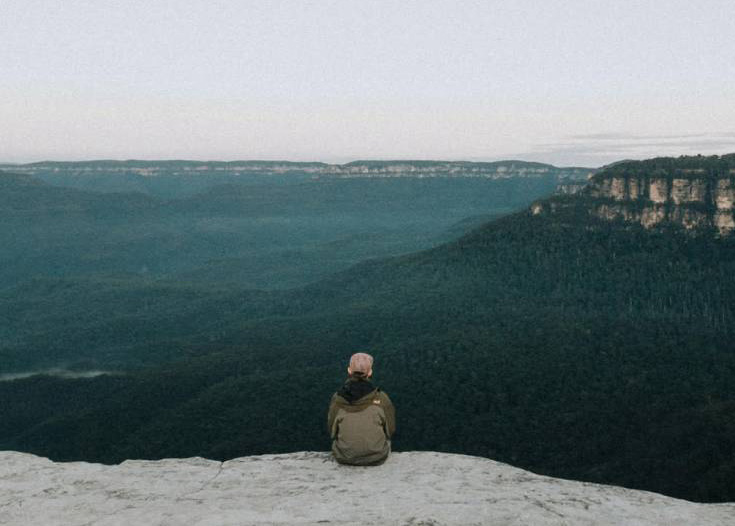In the 1960s, vision scientists conducted a famous study that would become known as the visual cliff experiment. In the study, researchers placed an infant on a table with half of it covered by a checkered cloth; her mother waiting at the other end of the table. At the edge of the cloth, in between the infant and her mother, was a glass plate, giving the appearance of a drop-off, that is, a “visual cliff.” Most infants would crawl up to the edge and stop just before the cliff, presumably to avoid falling, suggesting they have an innate capacity to perceive depth.
The visual cliff is a great metaphor for the process of awakening to the empty, spacious, luminous nature of our mind: there is a natural fear of crossing into the groundless plane of our buddhanature. Upon encountering that precipice, we might pause and retract, instead seeking the familiar comfort of our mental frameworks of self, imaginations, and habitual desires that have been a source of safety and protection throughout our life.
There is more to the story, though. The infants did not always stop at the edge. Diverse theories from modern psychology, in dialogue with Buddhist traditions, can help us understand our subtle fear of the spacious, boundless nature of awareness that precedes all conceptual thought and help take us further to venture beyond the apparent cliff.
To relax our goals, then, is one way to be freed from the conceptualizing process—we are free to settle into the ground of awareness that proceeds conceptualization.
Goals Are the Lynchpin of Experience
Buddhist traditions and cognitive science agree on a simple principle about the content of experience: The mind organizes perceptions and actions around goals. In The Evolution of Agency (2022), the developmental and comparative psychologist Michael Tomasello proposes that organisms from lizards to humans evaluate the environment according to whether a goal is being met or not, and flexibly choose to continue a course of action or retreat. When there is risk involved, we typically retreat.
Goals also shape how we organize information to navigate the world. When we think of any concept, such as a chair, the example that typically comes to mind is the one that best supports a particular goal. If we want a place to sit to read a book, a sofa chair is more likely to come to mind than a stool or a pumpkin, though one could sit on a pumpkin, after all. The goal is the lynchpin that holds the concept together and, over time, yields a self that automatically employs the concepts that are associated with its familiar goals.
The emphasis on goals in shaping mental content and action emerged in a strikingly parallel fashion in the writings of the seventh-century Buddhist philosopher, Dharmakirti. According to eminent Dharmakirti scholar John Dunne, goals are necessary to support action, even though they construct a perception that is not ultimately real. Consider the common experience of drinking hot coffee or tea from a mug: The object used to hold hot liquid is quickly conceptualized as a “mug,” but the object itself does not have an inherent reality or essence (svabhava) as a mug.
In the Dharmakirtian view, each object that we call a mug is utterly unique, but the mind suppresses these differences because each object in the category serves the same goal—to hold hot liquid—that non-mugs cannot serve. We wouldn’t call a water glass a mug because it would not work very well for drinking hot liquid. The goal to hold hot liquid also biases us to see the object as a mug and miss alternative creative realities, such as “paperweight,” or “pen holder,” or “flower pot.” This feature of the mind’s use of goals extends to the social world, too. Our goals influence whether we perceive others’ full humanity or not. In a work meeting, for example, if our minds are tightly focused on the goal of an agenda or outcome, we likely will not sense the full humanity and potential of each other, which then reduces the effectiveness of the group’s work. As Dunne has stated, “to choose a goal is to choose a reality.”
The emphasis on goals has practical implications for contemplative practice. In any moment that we experience an emotional pull or pattern of conceptual thought, we can notice the goal that is operating within that experience. We can then make a choice to pursue the goal, or to let the goal relax, and witness the untangling of various components of experience. With the goal gently relaxed, thoughts and perceptions can become less solidified as concrete realities, because the goal is the very glue that establishes a subject-object structure. Instead, with the goal relaxed, thoughts and perceptions can appear as fleeting sensations with a feeling of space in and through them, like a dream. In the same work meeting from above, we might be able to sense new possibilities and more capacity for connection with others.
The relaxation of goals aligns with non-dual contemplative traditions that employ phrases such as “not doing,” “not trying to cultivate anything,” “letting everything be,” “not meditating,” “don’t-know mind,” “put everything down,” “let go,” and so forth to help practitioners release the conceptual processing that maintains a subject-object structure. To relax our goals, then, is one way to be freed from the conceptualizing process—then we can see the “mug” freshly without grasping to it as only a mug. We are free to settle into the ground of awareness that proceeds conceptualization.
Venturing Beyond The Glass Cliff
In practice settings where I have shared these ideas, fellow practitioners have responded that letting go of goals into our more spacious, empty, luminous nature can evoke many challenges: fear of dying, fear of the mystery beyond the known, fear of losing control, fear of purposelessness, fear of abandoning justice and real dangers in the world, sloth, boredom, and so on.
The fear of relaxing our goals makes sense through the lens of psychological theories. From an evolutionary perspective, our brains are designed to form goals to protect the body and ensure survival. Letting go of goals violates our primal need for protection, agency, and drive for survival. Moreover, according to a well-established perspective called Terror Management Theory, when we come into contact with reminders of our impermanence, we tend to cling to familiar identities and defense mechanisms, worldviews, and so on, which can take the form of aggression and derogation toward those we perceive as threatening. Experiential contact with emptiness can trigger these various fears or inner defenses against vulnerability.
The good news is that there is a second part to the glass cliff study. When the infants’ mothers on the other side of the glass cliff expressed joy and curiosity, the infants continued crawling onto the glass plane. To let go of our familiar conceptual frameworks and wade into the uncertainty of emptiness is akin to crawling beyond the visual cliff. That can evoke resistance, but with the support of others who embody emptiness, we can learn to wade more confidently into our empty nature, just as an infant crawls onto the glass plane to join her mother. We have more confidence to venture beyond our familiar conceptualizations into the emptiness of awareness when there are others who inspire curiosity, courage, and safety. Accomplished spiritual teachers, practitioners, sangha, spiritual ancestors, lineage, deities, the natural world, and so forth have served this function, inviting us to join other awakened beings in the empty nature of mind where they abide. In fact, empirical research confirms that feelings of social support can help overcome the usual inner defenses that we employ against our mortality.
The relational scaffolding into spacious awareness that is characteristic of Buddhist traditions also makes deep sense within the evolutionary perspective noted above. When we face uncertainty between two routes of action, we tend to prefer the safe choice, and are less likely to engage in exploration and curiosity. Our close evolutionary ancestors felt more courage to face uncertainty when accompanied by others, for example, when searching for food. Those are the very qualities needed to relax our goals and crawl onto the glass cliff, to settle back into spacious awareness, and let things be. In meditative practice, when we experience the support of realized practitioners, community (sangha), and those who have come before us (lineage), we can feel safer to take the risk to relax our goals and experience the greater reward and nourishment that spacious, unconfined awareness offers.
Softening Into the Loving, Open Qualities that Precede Our Concepts
Instead of letting our thoughts solidify, we recognize their emptiness, then each thought that arises and disappears in the mind render the realization of emptiness ever clearer…What we have to do, therefore, is to melt the ice of concepts into the living water of the freedom within. —Dilgo Khyentse Rinpoche, Spirit of Tibet
The ability to assess goals and change course is a simple behavioral capacity enacted by lizards, squirrels, rodents, chimpanzees, and humans. We simply need to remember that we have that capacity: In any given moment, we have a choice to notice the goal that is operative, allow the goal to relax, and settle back into our deeper awareness.
Amidst the turbulence and suffering in our world, it might feel inappropriate to relax our goals. From a Buddhist perspective, however, relaxing our goals is necessary to realize our buddhanature. From there, we can ironically experience a greater expression of compassion and emptiness that can flexibly adapt to the situation and need. From that ground of awareness, we can take up activities and goals again, but now infused with the qualities of practice. Each time we let our goals relax, we make it easier to do so again in the future. This will increase the chance we might catch onto Dilgo Khyentse Rinpoche’s vision of “the living water of the freedom within” and experience the inner freedom, warmth, and joy that can transform our goals into a more natural, altruistic, and effective way of being.


